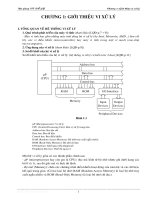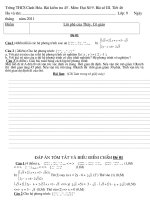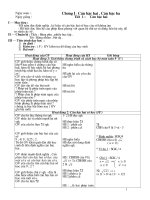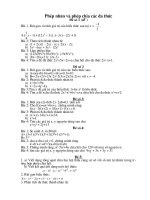Bài giảng enterprise resource planning chương 5
Bạn đang xem bản rút gọn của tài liệu. Xem và tải ngay bản đầy đủ của tài liệu tại đây (559.16 KB, 17 trang )
Enterprise Resource Planning, 1st
Edition by Mary Sumner
Chapter 5:
ERP Systems: Accounting and
Finance
© Prentice Hall, 2005: Enterprise Resource Planning, 1 st Edition by Mary Sumner
5-1/17
Objectives
•
•
•
Examine accounting systems within
ERP
Understand ERP financial systems
Review the interrelationships among
business processes supporting finance
and accounting
© Prentice Hall, 2005: Enterprise Resource Planning, 1 st Edition by Mary Sumner
5-2/17
Case: Atlantic Manufacturing
•
•
•
•
Inaccurate and/or incomplete
paperwork produces problems
Exchange of information between
departments made manually
Unable to supply quantity discount
information to sales force
Lack of coordination between
departments
© Prentice Hall, 2005: Enterprise Resource Planning, 1 st Edition by Mary Sumner
5-3/17
Accounting Processes
ã
Operational
management
level
Production of
transactions
ã
Paychecks,
invoices,
checks,
purchase
orders
â Prentice Hall, 2005: Enterprise Resource Planning, 1 st Edition by Mary Sumner
5-4/17
Management Control Processes
•
Budgeting
–
•
Cash management
–
–
•
Cash flow analysis
What-if analysis
Capital budgeting
–
•
Analysis of allocations, expenditures, revenues
Evaluation tools: NPV, IRR, pay-back period
Investment management
© Prentice Hall, 2005: Enterprise Resource Planning, 1 st Edition by Mary Sumner
5-5/17
Accounting Systems
•
Traditional
– Provide operational-level software
•
•
Produce invoices, checks, statements
Financial accounting
– Financial statements for external reporting
purposes
ã
Management accounting
Information on profitability
â Prentice Hall, 2005: Enterprise Resource Planning, 1 st Edition by Mary Sumner
5-6/17
Accounting Systems v. ERP
Modules
•
ERP
–
–
–
–
•
Information shares integrated database
Provides up-to-date information
Seamless
Creates document flow of transactions
Accounting systems
– Manual or separate transfer of information
– Multiple platforms
© Prentice Hall, 2005: Enterprise Resource Planning, 1 st Edition by Mary Sumner
5-7/17
© Prentice Hall, 2005: Enterprise Resource Planning, 1 st Edition by Mary Sumner
5-8/17
ERP Financial Accounting
Module
•
External reporting
–
–
•
Includes accounts receivable subsystem
–
–
•
Set by general accounting standards
Legal requirements
Interfaces with cash management
Monitors accounts and updates, handles
payments, creates due date lists, produces
statements
Accounts payable
–
Handles payments, applies available discounts to
maximize profits
© Prentice Hall, 2005: Enterprise Resource Planning, 1 st Edition by Mary Sumner
5-9/17
Management Accounting
Modules
•
Internal accounting perspectives for directing and controlling
operations
Information on variances between planned and actual data
Key activities
•
•
–
–
–
–
–
–
–
•
•
Cost center accounting
Internal orders as a basis for collecting and controlling costs
Activity-based costing of business processes
Product cost controlling for profitability analysis
Profitability analysis by market segment
Profit center accounting of individual areas of organization
Consolidation of financial data for accounting perspectives
Enable management to better allocate resources, maximizing
profitability and performance
Central clearinghouse for accounting information
© Prentice Hall, 2005: Enterprise Resource Planning, 1 st Edition by Mary Sumner
5-10/17
ERP Systems
•
Provide on-line, real-time data
–
Operational data
•
•
•
–
Feedback on quality and efficiency of processes
Information must be timely and specific
Used for real-time operational control
ABC data
•
•
•
•
•
Information on profitability and products
Real-time data
Estimates are sufficient
Strategic information
Basis for continuing improvement to operations
© Prentice Hall, 2005: Enterprise Resource Planning, 1 st Edition by Mary Sumner
5-11/17
© Prentice Hall, 2005: Enterprise Resource Planning, 1 st Edition by Mary Sumner
5-12/17
Featured Article: The Changing
Landscape of Computerized Accounting
Systems
•
•
Define each of the “in-technologies
and systems”.
What is their relationship to the
success of ERP?
© Prentice Hall, 2005: Enterprise Resource Planning, 1 st Edition by Mary Sumner
5-13/17
Featured Article: The Changing Landscape of
Computerized Accounting Systems, continued
•
New types of accounting software
–
–
Fair pricing
Database management standardized
•
–
•
Ease of mobility
PC-based
New markets
–
–
–
–
ERPs dominate highest end
Mid-levels are SQL-based and non-SQL-based
Low-end systems range from very low end to
more robust
E-commerce and e-business drive most mid- and
high-level systems, as well as a few low-level
© Prentice Hall, 2005: Enterprise Resource Planning, 1 st Edition by Mary Sumner
5-14/17
Featured Article: The Changing Landscape of
Computerized Accounting Systems, continued
•
Internet-based commerce
–
–
Hottest technology
E-business
•
•
–
E-commerce
•
•
•
Quicken allows remote entries through Web
EDI and EFT
Amazon.com and on-line securities trading
Dell Computer
ERP
–
–
Internet additions
Prices decreasing
© Prentice Hall, 2005: Enterprise Resource Planning, 1 st Edition by Mary Sumner
5-15/17
Featured Article: The Changing Landscape of
Computerized Accounting Systems, continued
•
Best practices
– Improve bottom line
– Create air of control
•
Structured Query Language
– Database of choice
© Prentice Hall, 2005: Enterprise Resource Planning, 1 st Edition by Mary Sumner
5-16/17
Summary
•
Most accounting processes operate at the
operational management level
–
–
•
Additional software enables financial and
management accounting
Each department or division may operate
different software and databases
ERP systems’ integrated database allow for
seamless information sharing
–
–
–
Easier reporting
Includes all operational data and ABC data
Coordinates with management accounting
modules
© Prentice Hall, 2005: Enterprise Resource Planning, 1 st Edition by Mary Sumner
5-17/17









